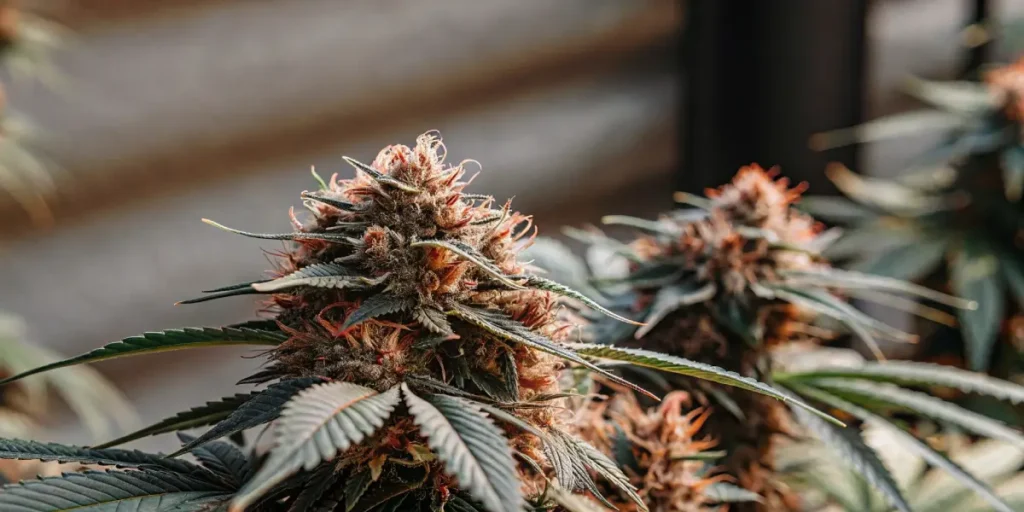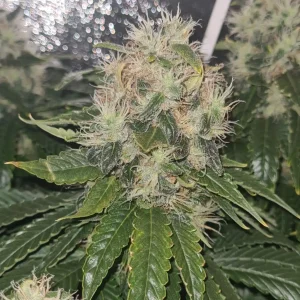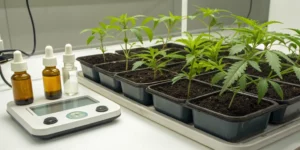Laughing Buddha is a popular sativa-dominant strain renowned for its uplifting effects and generous yields. To successfully cultivate this strain, it’s important to begin with selecting healthy seeds from a trusted provider. Once you’ve acquired your seeds, germination can be initiated using the paper towel method: dampen a paper towel, place the seeds within, fold it, and store it in a warm, dark area. After about 24 hours, seeds with emerging taproots are ready for planting in pre-prepared soil or a hydroponic system.
The initial stages of growing Laughing Buddha involve ensuring optimal conditions for seedlings to thrive. Ideally, the seedlings should be placed under a fluorescent light to provide 18 to 24 hours of light per day. Maintain a consistent temperature between 70-85°F (20-30°C) and humidity levels around 70% to promote healthy growth. During this phase, watering should be minimal to avoid any risk of root rot—just enough to keep the soil moist but not saturated.
As the plants enter the vegetative stage, usually after 2 to 4 weeks, switch to stronger lighting such as LED or HID lights. Continue providing at least 18 hours of light daily. It’s important to ensure that the plants receive a balanced nutrient mix with an appropriate N-P-K ratio to encourage vigorous growth. Keeping the temperature consistent and the humidity slightly lower at around 50-60% will help the plants thrive. Pruning and training techniques, like topping and LST, can be employed to increase yields and manage plant height.
Once the plants transition to the flowering stage, which typically occurs after about 8 to 10 weeks, adjust the light cycle to 12 hours of light and 12 hours of darkness to stimulate flowering. During this time, it’s crucial to alter the nutrient mix to promote blossoming with added phosphorous and potassium. The humidity should be lowered further to prevent mold and pests, ideally around 40%, and enhance overall bud quality.
Harvesting Laughing Buddha usually occurs around 10 to 12 weeks after flowering begins. Inspect trichomes using a magnifying glass; they should appear milky white, indicating peak THC levels. After harvesting, dry and cure the buds properly to preserve their incredible aroma and maximize their psychoactive properties. By following these meticulous steps, growers can enjoy a robust harvest of Laughing Buddha, celebrated for its euphoric and creativity-enhancing effects.
Laughing buddha Strain Overview: Traits, Effects & Genetics
The Laughing Buddha strain earns its place among cannabis enthusiasts with its distinctive and cheerful profile. Known for its energizing effects and uplifting nature, Laughing Buddha is an award-winning sativa-dominant hybrid. This strain impresses growers and users alike with its large buds and generous yields. The plant is characterized by its long, dense flowers peppered with fiery orange hairs and a rich trichome coating, hinting at its potent properties. The aroma of Laughing Buddha is both sweet and spicy, with tangy hints of tropical fruit, adding an exotic flair to its profile.
The effects of Laughing Buddha are predominantly invigorating and cerebral, making it an ideal choice for daytime use. Users often report an onset of euphoria that enhances mood and promotes a sense of happiness, aligning with its name. This strain is praised for creativity and focus, allowing individuals to delve into tasks with an enhanced mental clarity and a fresh perspective. Laughing Buddha is perfect for social gatherings, as it fosters talkativeness and laughter, creating a lively atmosphere among friends. Despite its stimulating effects, it manages to avoid overwhelming anxious feelings, providing a smooth and balanced high.
Genetically, Laughing Buddha is a carefully crafted hybrid primarily composed of sativa genetics. Bred by Barney’s Farm, it was developed by crossing the exotic Thai sativa with Jamaican strains, both known for their uplifting and invigorating effects. The selective combination of these genetics contributes to its robust growth, height, and substantial yields. This strain has also been credited with winning the prestigious High Times Cannabis Cup, underscoring its quality and appeal. Overall, Laughing Buddha’s unique blend of traits, effects, and genetics makes it an exemplary choice for both novice and seasoned cannabis enthusiasts.
Optimal Environment to Grow Laughing Buddha Successfully
Laughing Buddha, a sativa-dominant hybrid, thrives in a carefully controlled environment that mimics its natural tropical climate. When cultivating this strain, it’s crucial to maintain a warm and stable atmosphere. Ideally, the temperature should range between 20-30°C (68-86°F) during daylight hours. The temperature should not drop below 15°C (59°F) at night, as lower temperatures can impede the plant’s growth. Consistent temperature levels not only stimulate proper growth but also help in achieving the plant’s characteristic aromatic properties.
Another important factor is humidity. During the vegetative stage, Laughing Buddha flourishes best under 50-70% relative humidity. As it transitions to the flowering stage, gradually lowering the humidity to around 40-50% can prevent mold and mildew while enhancing bud development. Proper humidity control allows the plant to focus its energy on producing resinous buds. Indoor growers should use a hygrometer to monitor humidity levels and consider having a dehumidifier on hand to make necessary adjustments.
Light exposure is also a key determinant for the successful growth of Laughing Buddha. This strain benefits tremendously from a generous amount of light, which is vital for photosynthesis and robust growth. Employing high-intensity discharge (HID) lamps or full-spectrum LEDs can provide the plants with the necessary light intensity. For indoor growing, maintaining an 18/6 light schedule during the vegetative phase and switching to a 12/12 schedule during the flowering phase is recommended to optimize growth and encourage effective flowering.
Lastly, good air circulation and ventilation are fundamental for cultivating Laughing Buddha. Using oscillating fans can effectively distribute air and prevent heat accumulation within the grow space, reducing the risk of mold and pest infestations. Additionally, having an efficient exhaust system plays a significant role in eliminating excess heat and humidity. Ensuring the air is fresh and continually replenished will help maintain an ideal environment, resulting in healthier plants and a greater yield.
Grow Room Setup for Laughing Buddha Plants
Laughing Buddha, a sativa-dominant cannabis strain known for its uplifting effects and sweet, earthy aroma, thrives in a well-organized indoor grow room. To start, ensure your grow room is spacious enough to accommodate the tall stature of Laughing Buddha plants. Sativas like Laughing Buddha generally grow taller than indicas, so the minimum ceiling height should be at least 8 feet. This allows adequate vertical space for the plant’s growth as well as for efficient light penetration, which is crucial for this strain to maximize its yield and potency.
Lighting is a pivotal factor in the grow room setup for Laughing Buddha. High-Intensity Discharge (HID) lights like Metal Halide (MH) or High-Pressure Sodium (HPS) lights work best, as they provide the full spectrum needed for both vegetative and flowering stages. Additionally, consider using LED grow lights to reduce energy consumption and minimize heat output, which is essential for maintaining the ideal temperature range. Aim for a temperature between 70°F to 85°F during the day and slightly cooler at night to mimic natural outdoor conditions.
Maintaining proper air circulation is another critical aspect of fostering a healthy environment for Laughing Buddha. Use oscillating fans to promote air movement, preventing mold and mildew while supporting strong stem development. A reliable exhaust fan with a carbon filter is also essential to manage humidity levels and ensure continuous fresh air exchange. Keep humidity between 40% to 60% during the vegetative stage and reduce it to 30% to 40% in flowering to discourage mold growth and enhance resin production.
Finally, ensure your grow room has an adequate nutrient schedule tailored to Laughing Buddha’s needs. Use quality soil or a hydroponic system depending on your preference; organic soil with composted amendments works particularly well to retain flavor. Maintain a pH level between 6.0 and 6.5 for optimal nutrient absorption. Regular monitoring and adjustments based on the plant’s response will help you achieve the best possible results in your Laughing Buddha grows.
Indoor Growing Tips
Laughing Buddha is a popular strain among cannabis cultivators for its uplifting effects and relatively easy growth characteristics. When grown indoors, it offers a unique opportunity to control the environment and maximize yield. It is particularly suited for indoor growth due to its manageable height and bushy structure, which can be controlled with basic training techniques. To ensure optimal growth, it’s essential to pay attention to light, temperature, and nutrient delivery—factors that significantly impact the plant’s development.
Lighting is the cornerstone of a successful indoor Laughing Buddha grow. It thrives under high-intensity light sources such as LED or high-pressure sodium lamps. Ensure that the light cycle mimics the natural conditions typical for cannabis, adopting an 18/6 light to dark schedule during the vegetative stage and switching to a 12/12 schedule as it transitions to flowering. These cycles promote healthy photosynthesis and encourage vigorous growth, setting the stage for a higher yield.
Temperature and humidity play a crucial role in the development of Laughing Buddha. Maintaining a stable temperature range of 70-80°F (21-27°C) during the day and slightly cooler at night will optimize growth and stave off potential issues like mold and mildew. Meanwhile, humidity levels should be kept at approximately 40-50% to create an ideal environment. A consistent climate is crucial as temperature swings can stress the plant, potentially affecting its aroma and potency.
Nutrient management is also vital in the indoor cultivation of Laughing Buddha. This strain benefits from a balanced nutrient regimen that includes ample nitrogen during the vegetative stage and increased phosphorus and potassium during the flowering stage. It’s advisable to monitor pH levels and nutrient uptake closely to prevent nutrient lockout or deficiencies, which can hinder growth and yield.
Finally, indoor growers should regularly prune the Laughing Buddha plants to encourage bushier growth and improve air circulation. Strategic pruning of lower leaves and branches ensures adequate light penetration and reduces the risk of pests and diseases. This approach not only supports healthy development but also boosts the quality and quantity of the harvest.
Outdoor Growing Tips
Laughing Buddha is a delightful sativa strain that can provide growers with a generous yield under optimal conditions. When growing outdoors, it is crucial to consider the environment in which this strain will thrive. Being a sativa-dominant hybrid, Laughing Buddha enjoys warm, sunny climates similar to those found near the equator. If you reside in a temperate zone, consider planting this strain in a location that receives full sunlight to ensure robust growth and maximize yield potential.
One important aspect of outdoor growing is selecting the right time to plant. With Laughing Buddha, timing is key to taking advantage of the warm summer months. In the Northern Hemisphere, it is best to germinate seeds or transfer seedlings outdoors after the last frost has passed, typically around late spring. This will give the plants ample time to mature during the long summer days. In the Southern Hemisphere, aim to begin the outdoor grow cycle toward the end of September for the same reasons.
Regular monitoring of your Laughing Buddha plants is essential. This strain can reach a significant height, typically between 150-170 cm outdoors, so ensure you prepare adequate space for it to flourish. Pruning lower branches can help improve air circulation and light penetration, ensuring that bud development is not restricted. Additionally, keep an eye out for common pests and diseases that may affect outdoor cannabis, such as spider mites and powdery mildew. Implementing preventive measures, like natural predators and organic fungicides, can safeguard your plants and promote healthy growth.
Given enough time and care, Laughing Buddha usually completes its flowering phase in 11-12 weeks, making it ready for harvest around late October in the Northern Hemisphere. During the flowering stage, be extra vigilant with your feeding schedule. As Laughing Buddha is nutrient-hungry, especially towards the end of its life cycle, it’s essential to provide a balanced mix of fertilizers rich in phosphorus and potassium to enhance bud development and resin production. By doing so, you ensure that the plants can produce their characteristic uplifting and euphoric effects, typical of the Laughing Buddha experience.
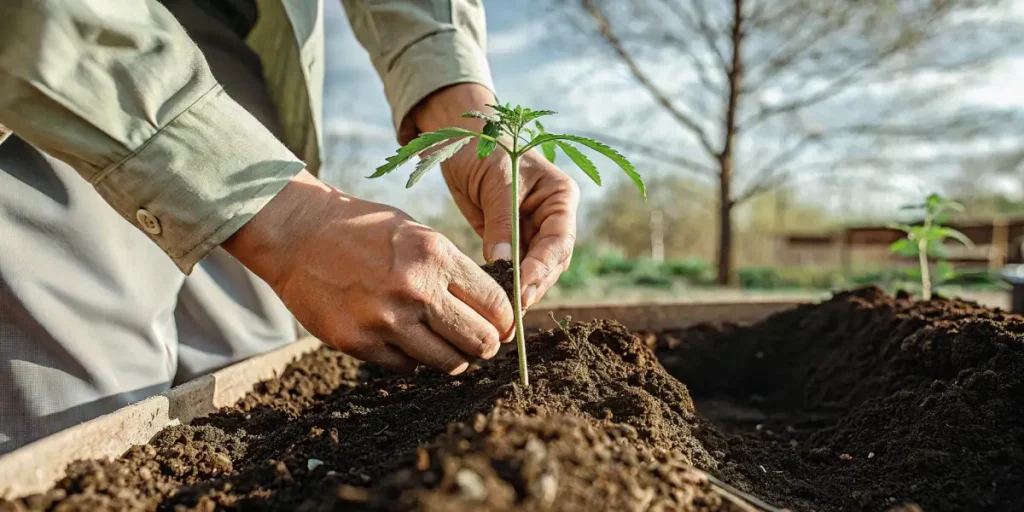
How to Germinate & Propagate Laughing Buddha
Germinating and propagating Laughing Buddha, a sativa-dominant hybrid known for its uplifting effects and delicious aroma, requires careful attention to detail and the right conditions. To begin the germination process, seeds should be acquired from a reputable source to ensure they are of high quality and viable. The process generally starts with a simple method known as paper towel germination. This involves placing seeds between damp paper towels, making sure they are adequately moist but not soaking wet, and placing them in a warm, dark location for several days.
During germination, maintaining the correct temperature and humidity levels is crucial. Ideally, seeds should be kept in an environment that is consistently between 70-85°F (21-29°C) to encourage sprouting. It is equally important to maintain the paper towels moist throughout the process; if they dry out, the seeds may fail to germinate. Generally, after about 3-7 days, the seeds should begin to crack open, and small white roots will appear, indicating successful germination and readiness for planting.
Once germinated, the Laughing Buddha seedlings will need to be transferred to a growing medium. A light, airy soil mixture that drains well yet retains some moisture is ideal. Small pots are great for initial growth, as they prevent overwatering and allow for easy transplantation later. When planting, each seedling should be placed root down into a small hole in the soil, ensuring the embryonic leaves remain above the soil. Water gently after planting to help settle the soil around the roots.
Propagation of Laughing Buddha can also be achieved through cloning, a process that involves taking cuttings from a mature, healthy plant. Select a sturdy branch with several nodes and at least a pair of healthy leaves, then cut at a 45-degree angle using sterilized equipment to prevent infection. Dip the cut end in a rooting hormone and plant it into a peat pellet or a similarly moist growing medium. Keep the clone in a controlled environment with high humidity and indirect lighting until roots develop.
Whether using seeds or clones, successful propagation of Laughing Buddha requires patience and care. As the plants grow, they will require ample light, preferably from full-spectrum grow lights, and regular but careful watering. Paying attention to environmental factors and providing a balanced, nutrient-rich feeding regimen will ensure that your Laughing Buddha plants thrive throughout their life cycle, leading to a bountiful harvest of aromatic, potent buds.
Vegetative Stage
The vegetative stage is a critical period in the growth cycle of your Laughing Buddha plants. During this phase, the plants focus on developing a sturdy structure with strong stems and lush foliage to support healthy bud production later on. As a sativa-dominant strain, Laughing Buddha tends to have a longer vegetative period compared to indica strains. Growers can expect this stage to last from 4 to 6 weeks or even longer, depending on the growing environment and goals. Providing the right conditions during this stage is crucial for optimal growth.
Light plays a pivotal role during the vegetative stage. Laughing Buddha thrives under intense light and requires at least 18 to 24 hours of light daily to maximize growth. Using high-intensity discharge lamps such as metal halide (MH) or full-spectrum LED lights will provide the necessary spectrum for vigorous vegetative growth. Ensuring lights are placed at the right distance from the canopy will prevent light burn and promote even growth. Regularly adjust the light fixtures to accommodate plant height as they grow.
The nutrient uptake during the vegetative stage is also essential for robust development. Laughing Buddha plants benefit from a nitrogen-rich nutrient formula that supports leafy growth. Implementing a balanced feeding schedule and monitoring plant responses to nutrients can prevent nutrient deficiencies or burn. Alongside nitrogen, calcium and magnesium are crucial secondary nutrients that contribute to the overall health of your plants. Maintaining an optimal pH level between 6.0 and 7.0 in soil or 5.5 to 6.5 in hydroponics ensures efficient nutrient absorption.
Environmental conditions such as temperature and humidity should mimic the natural growth environment of Laughing Buddha. Aim for temperatures between 70°F and 85°F (21°C to 29°C) with humidity levels around 50% to 70% during the vegetative stage. Good air circulation is required to prevent mold and pests, and supports stronger plant branches. Employ fans to promote air flow and reduce humidity levels if necessary. Regularly inspecting the plants for signs of stress, diseases, or pests is vital to catch any potential issues early.
Pruning and training techniques are useful in managing the size and shape of your Laughing Buddha plants, especially considering their sativa lineage, which tends to grow tall and lanky. Employ techniques such as topping or FIMing to encourage bushier growth and increase potential bud sites. Low-stress training (LST) helps spread the plant canopy to optimize light exposure to all parts of the plant. Consistent monitoring and gentle adjustments will direct the growth as desired and improve the eventual yield during flowering.
Flowering: What to Expect
Laughing Buddha, an award-winning strain, is renowned for its uplifting effects and sweet, fruity aroma. Cultivating Laughing Buddha demands patience, especially during the flowering stage, which is crucial to achieving its full potential. Typically, the flowering period for this sativa-dominant strain spans around 9 to 10 weeks. During this time, growers should expect the plant to stretch significantly, often doubling in size as it transitions from vegetative growth to flowering. It’s essential to ensure that the plant has ample space both vertically and horizontally to accommodate this growth spurt.
As Laughing Buddha enters the flowering stage, you will notice an explosion of buds forming along its branches. These buds are characteristically dense and coated with a thick layer of trichomes, giving them a frosty appearance. The aroma becomes increasingly pronounced, featuring sweet and spicy notes with a distinct tropical fruitiness. This delightful scent is indicative of the rich terpene profile that Laughing Buddha has to offer. To support the plant during this critical phase, it’s important to maintain an optimal environment with temperatures between 70-80°F (21-26°C) and relative humidity around 40-50%.
Nutrient management is another critical aspect during the flowering of Laughing Buddha. As the plant focuses its energy on bud development, ensuring a balanced nutrient profile, rich in phosphorus and potassium, will support healthy growth. It is also crucial to monitor for signs of nutrient deficiencies or excesses, such as yellowing leaves or tip burn, and adjust your feeding regimen accordingly. Proper care and attention to the environment and nutrients will ultimately result in a rewarding yield of high-quality buds.
During the final weeks of flowering, growers should keep a close eye on the trichomes to determine the optimal harvest time. The trichomes will shift from clear to milky, and eventually, some will turn amber, signaling peak potency. Harvesting at the right time ensures the best combination of THC levels and terpene profile, capturing the quintessential qualities of Laughing Buddha. By meticulously managing the flowering stage, growers can look forward to an abundant harvest of this exceptional strain, celebrated for its cheerful effects and enticing aroma.
Fertilizers & Nutrient Schedule
Growing the Laughing Buddha cannabis strain successfully requires attention to its specific nutritional needs. As a sativa-dominant hybrid, Laughing Buddha tends to have a longer flowering period, making a tailored nutrient schedule crucial for optimal growth. In the vegetative stage, this strain benefits significantly from a balanced mix of vital nutrients. Start by administering a nutrient-rich soil amendment or quality hydroponic nutrient solution rich in nitrogen, phosphorus, and potassium. These elements support rapid plant growth, foliage development, and root establishment, laying a robust foundation for the plant’s future yield.
As Laughing Buddha transitions to the flowering phase, its nutrient requirements shift. While nitrogen is still necessary, the demand for phosphorus and potassium increases to support bud development and enhance the plant’s energy utilization. A bloom-specific fertilizer with a nutrient ratio of about 1:3:3 (N:P:K) effectively encourages the plant to produce abundant flowers. It is advisable to gradually increase the concentration of these nutrients at the beginning of the flowering stage, aligning with the plant’s natural growth cycle. Maintaining consistency in feeding while ensuring the absence of nutrient lockout is vital for healthy flowering.
Weekly monitoring of the Laughing Buddha’s response to feedings can help fine-tune nutrient schedules. Overfeeding can lead to nutrient burn, while underfeeding may result in stunted growth and poor yields. Employing additional micronutrients like calcium, magnesium, and sulfur offers supplementary support for the plant’s overall health and resistance to pests and diseases. Regular pH checks and adjustments of water and nutrient solutions also optimize nutrient absorption. Knowing the specific requirements of Laughing Buddha and adapting the nutrient schedule to its growth stages can lead to bountiful harvests and the strain’s signature aromatic, uplifting buds.
Pest and Disease Prevention for Healthy Cannabis Plants
Growing Laughing Buddha, like other cannabis strains, requires meticulous attention to pest and disease prevention to ensure vigorous and healthy plants. One of the fundamental strategies is to maintain a clean growing environment. This involves thoroughly cleaning all tools and equipment before use, as dirty tools can harbor pathogens and pests. Regular cleaning and sanitization of the growing area will significantly reduce the likelihood of disease outbreaks. Furthermore, introducing beneficial insects such as ladybugs can serve as a natural pest control measure, effectively keeping harmful pests at bay without the use of chemical pesticides.
Another critical aspect of pest and disease prevention is proper plant nutrition and watering. Laughing Buddha plants, when deprived of essential nutrients, become susceptible to diseases and pest infestations due to stress. Regularly check the pH and nutrient levels to ensure they are within the optimal range for cannabis. Overwatering or underwatering can lead to conditions like root rot or weakened immune responses in the plants. Consistently monitoring soil moisture and providing adequate drainage will help maintain healthy roots and prevent fungal diseases.
A vigilant monitoring routine is imperative to catch early signs of pest or disease problems in Laughing Buddha plants. Regularly inspect leaves, stems, and buds for any unusual spotting, discoloration, or webbing that may indicate the presence of pests such as spider mites or aphids. Early detection allows for prompt intervention with natural or organic treatments, minimizing damage and preventing the spread of infestations. Implementing these practices within Integrated Pest Management (IPM) frameworks can create a holistic approach to maintaining plant health, ultimately leading to higher yields and resilient plants.
Finally, cultivating a diverse garden with companion plants can offer additional protection for Laughing Buddha cannabis plants. Certain plants act as natural repellents for common pests, creating a protective barrier around your cannabis. For example, marigolds and basil are known for their pest-repelling properties and can be strategically planted near cannabis to ward off potential threats. Overall, combining environmental sanitation, proper plant care, diligent monitoring, and strategic plant interactions forms an effective strategy for preventing pests and diseases in Laughing Buddha cultivation.
Harvesting & Drying Laughing Buddha the Right Way
Successful cultivation of Laughing Buddha culminates in the crucial stages of harvesting and drying, where the ultimate potential of your crop is realized. Laughing Buddha is prized for its uplifting effects and unique aroma, largely due to its fine blend of sativa genetics. First, carefully observe the plant’s trichomes—those tiny glandular hairs that coat the buds. The ideal moment for harvesting occurs when trichomes shift from clear to a cloudy milky white, with a few turning amber, signaling peak cannabinoid content. Typically, this occurs around 70-75 days of flowering for Laughing Buddha.
When it’s time to harvest, ensure that you do so during the day when the plant’s sugars are most concentrated. Use sterilized trimming scissors or shears to cut the branches one at a time. For ease of handling, maintain at least six inches of stem with each cut to use as a handle. Keep the environment calm to avoid agitation of the cannabinoid-rich resin. It’s advisable to wear gloves during this entire process to prevent contamination and to maintain resin integrity.
Proper drying is paramount to preserve the tantalizing aroma and potent effects of Laughing Buddha. After trimming excess fan leaves, hang the branches upside down in a controlled environment. Aim for a room temperature of 60-70°F (15-21°C) and maintain humidity levels at 50-60%. This balance prevents mold while allowing the buds to dry evenly. An oscillating fan can help maintain consistent air flow, but be sure it is not directly blowing on the flowers.
The drying process should take 7-12 days, depending on environmental factors and bud density. Once the outer areas of your buds feel dry to the touch and the smaller stems snap easily, begin the curing process. Place the dried buds into airtight glass jars, filling them to about three-quarters full to allow some air space. Store these jars in a dark, cool place, opening them daily for the first two weeks to release built-up moisture, balancing the internal humidity. This step significantly enhances Laughing Buddha’s delightful effects and ensures a smooth aroma and flavor.
Laughing buddha Strain Type: Indica, Sativa or Hybrid?
Laughing Buddha is an intriguing and well-balanced cannabis strain that is classified as a Hybrid, leaning towards a Sativa dominance. This strain is a result of an expert blend of Thai and Jamaican genetics. Laughing Buddha typically exhibits about 75% Sativa to 25% Indica traits, making it a popular choice for users seeking cerebral effects characteristic of Sativa strains while still enjoying the calming influences of Indica. Its composition makes Laughing Buddha a versatile strain ideal for various usage scenarios, offering both relaxation and upliftment without overwhelming either side of the spectrum.
The Sativa dominance in Laughing Buddha manifests through its energetic and uplifting properties. Consumers often report a rush of euphoria almost immediately after consumption, coupled with heightened creativity and sociability, making this strain perfect for daytime use and social gatherings. The complexity of its Sativa lineage allows the strain to deliver an exciting mental buzz, often stimulating productivity and creativity, which is very appealing to many consumers seeking motivation or mood elevation during the day.
While Laughing Buddha is predominantly Sativa, its Indica composition does contribute notable benefits to its overall effect profile. The Indica traits in Laughing Buddha provide a subtle, relaxing undertone that keeps the energetic Sativa effects from becoming too overwhelming or jittery. This well-rounded balance allows users to experience a smooth transition into relaxation without an intense sedative sensation, making it suitable for evening use as well. This hybrid nature, with its moderate THC levels, ensures a pleasant experience whether you’re seeking stress relief, pain management, or just looking to unwind after a long day.
Growers of the Laughing Buddha strain should be aware of its hybrid nature, impacting its growth patterns and care requirements. The Sativa traits dominate the plant’s structure, resulting in relatively tall plants with longer flowering times, typical of Sativa strains. However, thanks to its Indica heritage, the plant is also known to produce dense, resin-rich buds. Cultivating this strain successfully requires adequate space and a commitment to managing its considerable scent, but those who master its cultivation are rewarded with a generous yield of premium buds. The well-balanced nature of Laughing Buddha’s strain type thus isn’t confined just to the consumer experience, but is evident throughout the growth process as well.
Why Grow Laughing Buddha? Key Benefits for Cultivators
Laughing Buddha is a remarkable strain that has gained popularity among both novice and experienced cannabis growers. One of the primary reasons cultivators are drawn to this strain is its unique genetic profile. Laughing Buddha is a sativa-dominant hybrid originally developed by crossing Thai and Jamaican strains. This combination results in a plant with distinct tropical and sweet flavors, which adds a unique appeal to any grower’s garden. The strain’s reputation for inducing uplifting and energetic effects further enhances its desirability, making it especially popular for daytime consumption.
Besides to its appealing characteristics, Laughing Buddha offers cultivators an impressive yield. Under optimal conditions, growers can expect substantial harvests that are above average compared to many other sativa strains. Typically, Laughing Buddha thrives in a warm Mediterranean-like climate, which suits indoor cultivation setups with regulated environments. It tends to flower within 9 to 10 weeks, a relatively short time frame for sativa strains. This quick turnaround allows growers to enjoy the fruits of their labor in a shorter period while maximizing their productivity across multiple growing cycles.
Moreover, this strain is known for its resilience against common cannabis pests and mold, making it an ideal choice for cultivators seeking a robust and forgiving plant. Laughing Buddha’s resilience means growers face fewer challenges related to maintaining plant health, leading to decreased dependency on pest control measures and allowing for a more organic growing process. The combination of high resin production and dense buds further reinforces its allure as a commercially viable strain, as the resultant high-quality product commands strong demand in the market.
Ultimately, Laughing Buddha offers a plethora of benefits for cultivators, from its enticing flavor profile and elevated yields to its manageable growing requirements. Its resistance to pests and mold ensures a smoother cultivation experience, making it suitable even for those new to cannabis growing. Overall, dedicating space to grow Laughing Buddha in your garden or indoor setup can yield rewarding results, both in terms of plant quality and grower satisfaction.
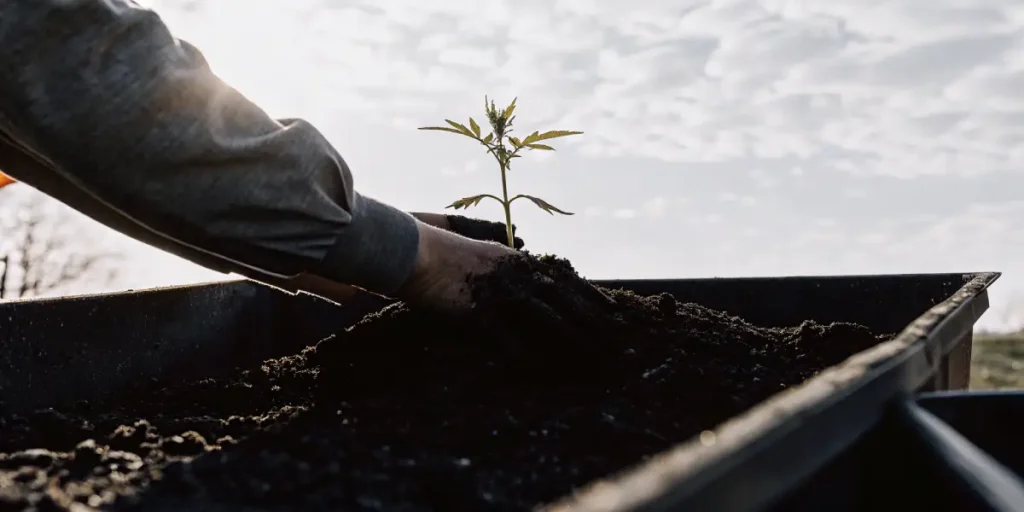
Potential Challenges When Growing Laughing Buddha
Laughing Buddha, a sativa-dominant hybrid, is known for its delightful effects and unique growth characteristics. However, cultivating this strain can present several challenges for growers. First and foremost, Laughing Buddha plants often require longer flowering times compared to other strains. Typically, they take around 9 to 10 weeks to flower, which might test the patience of new growers looking for quicker yields. A longer flowering period means a more extended commitment to maintaining optimal growth conditions, which can be demanding, especially for those with limited space or resources.
Another challenge while growing Laughing Buddha is its susceptibility to mold and mildew. This strain has dense buds, which can be problematic if humidity levels are not carefully controlled. High humidity can create an environment conducive to mold and mildew, particularly during the late flowering stages. To overcome this, growers must ensure adequate ventilation and maintain humidity levels within a safe range, typically between 40-50% during flowering. Constant monitoring and adjusting humidity levels can be labor-intensive, necessitating diligence and a bit of experience.
Besides to mold and mildew, Laughing Buddha’s substantial height can pose another challenge. As a sativa-dominant strain, it can stretch significantly during its vegetative phase. This growth characteristic demands a lot of vertical space, which can be problematic for indoor growers with limited ceiling height. To manage this, growers should consider training techniques such as topping, low-stress training (LST), or using a screen of green (ScrOG) to control the plant’s height and maximize light exposure. These techniques require a level of skill and attention to detail that can be daunting for beginners.
Lastly, nutrient management is crucial when growing Laughing Buddha. This strain can be sensitive to over-fertilization, particularly with nitrogen. Excessive nutrients can lead to nutrient burn, manifesting as yellowing leaves and stunted growth. Growers should take a conservative approach to feeding, gradually increasing nutrient levels while carefully observing the plants’ reactions. This cautious, incremental method helps prevent nutrient burn and supports the overall health of the plants, but requires careful observation and knowledge of plant nutrition.
Ultimately, while Laughing Buddha is a popular strain due to its uplifting effects, it presents several challenges that growers must address. By managing flowering times, humidity, plant height, and nutrient intake, dedicated growers can successfully cultivate Laughing Buddha, enjoying the rewarding experience of growing this unique and potent strain.
Is Laughing Buddha Worth Buying? Here’s What You Need to Know
Laughing Buddha is a popular strain among cannabis enthusiasts, known for its uplifting and euphoric effects. Originating from a blend of Thai and Jamaican sativas, this strain has gained a reputation for its distinctive sweet and spicy aroma, followed by a hint of fresh fruit. Its unique characteristics make it a desirable option for both recreational and medicinal users, looking to enhance their mood or alleviate stress and anxiety. However, before purchasing this strain, it’s essential to understand its benefits and potential drawbacks to ensure it aligns with your preferences and needs.
For growers, Laughing Buddha presents moderate cultivation challenges. It typically thrives in a controlled indoor environment but can be grown outdoors in warm climates with consistent sunlight. This strain has a relatively longer flowering period, spanning around 9 to 10 weeks. However, patient cultivators are often rewarded with bountiful yields. The plants grow tall and dense, which necessitates ample space and regular pruning to ensure adequate light penetration and air circulation. As a balanced sativa-dominant hybrid, Laughing Buddha offers a rewarding cultivation experience for those willing to invest time and effort.
Potential buyers should consider Laughing Buddha’s distinct sativa effects. Known for its cerebral high, this strain can provide a burst of energy and creativity, making it suitable for daytime use or social gatherings. Medical users might find it beneficial for managing conditions like depression, fatigue, or pain. However, due to its potency, inexperienced users may experience heightened levels of anxiety if consumed in large quantities. It is advisable to begin with smaller doses to gauge the body’s reaction.
Overall, whether Laughing Buddha is worth buying largely depends on individual preferences and growing experience. Its uplifting and potent effects make it a standout choice for those seeking a productive and joyful high. However, its cultivation requirements and power may not be ideal for all users, especially novice growers or those sensitive to sativa strains. By knowing its attributes and growing demands, potential buyers can make an informed decision about adding Laughing Buddha to their collection.
FAQs about Laughing Buddha
Who is the Laughing Buddha?
The Laughing Buddha, also known as Budai or Hotei, is a symbol in Chinese and Japanese cultures, representing wealth, happiness, and contentment. Unlike Gautama Buddha, who is the founder of Buddhism, the Laughing Buddha is inspired by a Chinese Zen monk named Qieci who lived over a thousand years ago. His rotund figure and jovial smile promote the joy of living and are often seen in homes and businesses as a symbol of good fortune.
What does the Laughing Buddha symbolize?
The Laughing Buddha is commonly associated with happiness, prosperity, and abundance. His large belly is thought to signify wealth and comfort, while his laughing face promotes the idea of joyfulness and positive energy. Many people use figurines of the Laughing Buddha as a talisman or Feng Shui element to attract good luck and dispel negative energy.
Where should I place a Laughing Buddha statue in my home?
According to Feng Shui principles, the Laughing Buddha should be placed in the southeast corner of your living space, which is considered the wealth corner. Alternatively, placing it near the main entryway of your home can invite prosperity, as it’s believed that the Laughing Buddha welcomes positive chi, or energy, into the household. Ensure it is at a height that allows you to admire it easily, promoting positivity in your surroundings.
Are there different types of Laughing Buddha statues, and do they mean different things?
Yes, there are various forms of Laughing Buddha statues, each symbolizing different aspects of prosperity and happiness. For example, a Laughing Buddha holding a gold nugget symbolizes wealth, while one with a sack over his shoulder represents traveling and collecting wealth from all corners of the Earth. Each variation serves a unique purpose, so individuals often choose based on the specific kind of good fortune or life aspect they wish to enhance.
Can anyone have a Laughing Buddha, or is it specific to certain cultures?
While the Laughing Buddha originates from Eastern religious practices, it has become a universally beloved figure due to its symbolism of joy and abundance. People worldwide embrace its symbolism of happiness and prosperity, integrating it into their homes or workplaces. Individuals from diverse backgrounds can appreciate and benefit from the presence of a Laughing Buddha statue, promoting well-being and positive energy universally.

